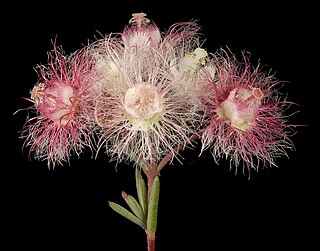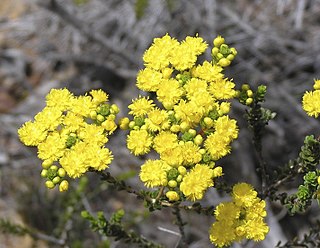
Verticordia huegelii, commonly known as variegated featherflower, is a flowering plant in the myrtle family, Myrtaceae and is endemic to the south-west of Western Australia. It is a sometimes an erect shrub, sometimes sprawling to almost prostrate. It has linear leaves and very feathery flowers in spring. The flowers are usually cream-coloured or white, becoming pinkish and reddish or maroon as the flowers age, giving a variegated appearance to the display.
Verticordia brachypoda is a flowering plant in the myrtle family, Myrtaceae and is endemic to the south-west of Western Australia. It is an irregularly branched shrub with narrow leaves crowded on side-branches, and cream-coloured or white flowers with pink, cream or white centres.
Verticordia carinata, commonly known as pea-shaped featherflower or Stirling Range featherflower, is a flowering plant in the myrtle family, Myrtaceae and is endemic to Western Australia. It is an erect, spindly shrub with small, well-spaced leaves and pink and red flowers. It is a rarely seen plant, not known between its description in 1849 and its rediscovery in 1990.

Verticordia monadelpha is a flowering plant in the myrtle family Myrtaceae, and is endemic to the south-west of Western Australia. It is a much-branched shrub with pink to magenta flowers in spring and early summer. It is commonly known as pink Morrison, woolly featherflower, pink woolly featherflower, white woolly featherflower or pink cauliflower.

Verticordia staminosa is a flowering plant in the myrtle family, Myrtaceae and is endemic to the south-west of Western Australia. It is a shrub comprising two subspecies, one of which has two varieties. All three types have a limited distribution and have been classified as "Threatened". It is distinguished from other species of verticordia by its prominent, long stamens which extend well beyond its feathery yellow sepals and petals.

Verticordia fastigiata, commonly known as mouse featherflower, is a flowering plant in the myrtle family, Myrtaceae and is endemic to the south-west of Western Australia. It is a prostrate or low shrub with small, club-shaped leaves and mouse-scented flowers which vary in colour from golden-yellow and orange to dark red.
Verticordia densiflora var. cespitosa is a flowering plant in the myrtle family, Myrtaceae and is endemic to the south-west of Western Australia. It is a shrub with small leaves and pink, or pink and white flowers. It is one of five varieties of the species Verticordia densiflora.
Verticordia densiflora var. pedunculata, commonly known as long-stalked featherflower, is a flowering plant in the myrtle family, Myrtaceae and is endemic to the south-west of Western Australia. It is a shrub with small leaves and mauve-pink flowers which fade to white. It is one of five varieties of the species Verticordia densiflora and is distinguished from the others by its much longer flower stalks.
Verticordia densiflora var. stelluligera is a flowering plant in the myrtle family, Myrtaceae and is endemic to the south-west of Western Australia. It is an openly branched shrub with small leaves and small clusters of yellowish or pink and cream flowers. It is one of 5 varieties of the species Verticordia densiflora.

Verticordia etheliana is a flowering plant in the myrtle family, Myrtaceae and is endemic to the south-west of Western Australia. It is a shrub with one highly branched main stem, egg-shaped to almost round leaves and spike-like groups of bright red flowers with greenish-cream centres.

Verticordia fimbrilepis, commonly known as shy featherflower, is a flowering plant in the myrtle family, Myrtaceae and is endemic to the south-west of Western Australia. It is a small, bushy shrub with one openly branched main stem at its base, small, pointed leaves and rounded groups of pink flowers near the ends of the branches.

Verticordia fimbrilepis subsp. fimbrilepis is a flowering plant in the myrtle family, Myrtaceae and is endemic to the south-west of Western Australia. It is a small bushy shrub with one openly branched main stem at its base, small, pointed leaves and rounded groups of pink flowers near the ends of the branches.
Verticordia fimbrilepis subsp. australis, commonly known as southern shy featherflower is a flowering plant in the myrtle family, Myrtaceae and is endemic to the south-west of Western Australia. It is a slender shrub with one openly branched main stem at its base, small, pointed leaves and rounded groups of pink flowers near the ends of the branches.

Verticordia huegelii var. huegelii, commonly known as variegated featherflower, is a flowering plant in the myrtle family, Myrtaceae and is endemic to the south-west of Western Australia. It is an upright, slender or bushy shrub, with creamish-white flowers turning pink or reddish maroon as they age, giving the plant a variegated appearance. It is similar to Verticordia huegelii var. decumbens but is more upright than that variety and lacks a lignotuber.

Verticordia huegelii var. decumbens, commonly known as variegated featherflower, is a flowering plant in the myrtle family, Myrtaceae and is endemic to the south-west of Western Australia. It is an almost prostrate shrub, with creamish-lemon coloured flowers turning pink then red as they age, giving the plant a variegated appearance. It is similar to Verticordia huegelii var. huegelii but has a lignotuber and a lower growth habit.
Verticordia huegelii var. tridens, commonly known as variegated featherflower, is a flowering plant in the myrtle family, Myrtaceae and is endemic to the south-west of Western Australia. It is a slender, open, sometimes straggly shrub with bright yellow flowers which age to red and then brown and differently-shaped staminodes from the other varieties of the species.

Verticordia laciniata is a flowering plant in the myrtle family, Myrtaceae and is endemic to the south-west of Western Australia. It is an openly branched shrub with linear, slightly hairy leaves and heads of scented, bright yellow flowers which turn red then bronze-coloured as they age.
Verticordia multiflora is a flowering plant in the myrtle family, Myrtaceae and is endemic to the south-west of Western Australia. It is a small, openly branched shrub with small leaves and groups of scented, bright yellow flowers on the ends of the branches in spring or early summer.

Verticordia oxylepis, commonly known as bonsai featherflower, is a flowering plant in the myrtle family, Myrtaceae and is endemic to the south-west of Western Australia. It is a small shrub, often with a layered appearance, small leaves and very small yellow and pink flowers.

Verticordia serrata is a flowering plant in the myrtle family, Myrtaceae and is endemic to the south-west of Western Australia. It is a spindly or openly branched shrub with hairy, egg-shaped leaves and flowers which are golden at first, then fade to a greyish colour.










